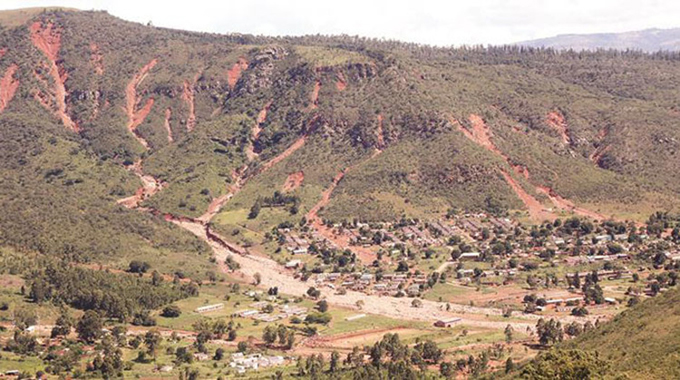Rangelands could be the answer for cattle deaths

Obert Chifamba Agri- Insight
CLIMATE change has in essence compounded an already grim situation for cattle farmers in the country’s arid and semi-arid regions where for decades they have had to dig deeper into their bags of tricks to keep their livestock alive or watch helplessly as they die helplessly.
So dire is the situation that some farmers have gone to the extent of adopting relief grazing in which they take their cattle to distant places that have pastures and water and camp there for the entire dry season as water and graze would be a rarity in their homelands.
A livestock expert based in Matabeleland South once told me that cattle in the region have for years survived on grass that thrives on moisture from the little rains typical of arid regions and that there is minimal leaching of nutrients in the soil.
This, he said, allows the grass that manages to germinate to be very rich in nutrients, which are then passed on to cattle to see them growing into big, healthy animals.
This, plus the mopani vegetation and brown pods from acacia trees, always provide something as nutritious as feed concentrates people buy from shops, he hinted.
But climate change has since put paid to any hopes of nature continuing to nurture its own, as very little in terms of grass now makes it to the surface while the availability of shrubbery that used to complete the menu is now an absolute joke too.
The situation has caused poverty deaths among cattle and even donkeys in worst case scenarios.
Efforts to save cattle from drought-inspired deaths have also seen the Government intervening to introduce hay baling in the Mashonaland provinces, mostly and having it shipped to drier areas during the dry season, but these have not been enough to meet demand.
Those farmers seeking to buy their own baled grass have had to contend with charges of between $80 and $100 per 15 kilogramme bale, which is making it expensive and, therefore, unsustainable for most resource poor farmers to continue.
Statistics from the Department of Veterinary Services (DVS) show that the southern parts of the country are the worst affected and as at October 17, the drought had claimed 1 167 cattle and 35 donkeys in four provinces.
A total of 240 cattle deaths were reported in Midlands Province, 291 in Matabeleland South, 218 in Matabeleland North, while Masvingo Province had 418 cattle and 35 donkey deaths.
There is a high possibility the number of cattle deaths could be more than those recorded as some cases go unreported.
But recent developments in Matabeleland in which the Department of Research and Specialist Services (DRSS) in collaboration with ICRISAT have started a programme of rangeland mapping that is initially targeting over 7 000 farmers in Insiza and Matobo districts seem to be bringing a gleam of hope to the currently hapless situation.
The European Union under the Zimbabwe Agriculture Knowledge and Innovation Systems (ZAKIS) project is supporting the initiative that is aimed at improving the productivity of communal pastures in the country’s semi-arid areas.
The mapping exercise involves the protection, conservation, and improvement of land, water, plant, and animal resources to ensure that they sustainably produce feed for both domestic livestock and wild animals.
Rangelands are those lands on which the native vegetation (climax or natural potential plant community) is predominantly grasses, grass-like plants, forbs, or shrubs suitable for grazing or browsing use.
On the one hand, pastures are those lands that are primarily used for the production of adapted, domesticated forage plants for livestock.
They are distinguished from pasture lands by the fact that they maintain native vegetation rather than what has been established by humans.
Rangelands include many different climates and contain land that cannot be grazed. Grazing is an important use for rangelands, but they are not defined by grazing even if grazing can be used as a way of managing them. The mapping exercise will promote the establishment of palatable vegetation species that play a significant role in the diets of livestock such as cattle and goats, while providing the opportunity for implementing partners to assess the condition of pastures in the selected wards of the two districts.
This is important as it will assist in planning the interventions that are designed to redress current challenges and boost fodder productivity and help push the national agenda of building the capacity of livestock value chains and improve the quality of the national herd.
It is no secret that pastures in the semi-arid regions of the country where extensive livestock production is the main agricultural activity are the backbone of livelihoods and food security there, hence the need to save cattle and other livestock units from poverty deaths.
This naturally calls for spirited efforts by scientists, extension officers, and other stakeholders to maintain the rangelands to guarantee sustainable yields of grazing and forage.
But while all these efforts being made to save cattle, the farmers should do themselves a favour by adopting a business approach to everything they do, which must start with the selling of unproductive cattle and using the proceeds to buy feeds for the remaining stock.
Farmers need to realise that inadequate grazing always leads to illegal movements and straying of animals in search of grazing and watering, which heightens chances of them mixing with herds infected with communicable diseases.
In a way, this is a wake-up call for farmers to accommodate exercises like de-stocking in their cattle production schedules and always have the guts to dispose of older animals and save younger and productive ones.
This will allow them to even pool resources and drill boreholes to get water for their animals since most deaths are now caused by lack of water and pastures while there will also be no stuff such as baled grass for survival feeding.
Of course, the most affected areas are Masvingo, Matabeleland South, Matabeleland North, south of Midlands, Muzarabani and south of Manicaland, but the sad reality is that this is not happening for the first time.
It is something that has been happening for some time now, yet the farmers do not seem to realise that no one watches a stone that is about to strike them without ducking. They need to start acting too.
The farmers must make it a habit to always secure supplementary feeding in the form of crop residue, hay bales and salt licks where possible and not wait for the intervention of Government or other concerned parties.
Their biggest undoing in most cases is the failure to shake off the mentality of keeping cattle for sentimental values, but must see dollar signs in their animals each time they look at them.
This idea of farmers valuing livestock so much that they end up losing out because they do not want to sell has always left them poorer. They need to save the best of the stock using the minimum resources available so they have to sacrifice and remove unproductive animals and create more pastures for the remaining stock.







Comments